HBx protein: Essential for replication after HBV infection
- Normal Liver Cells Found to Promote Cancer Metastasis to the Liver
- Nearly 80% Complete Remission: Breakthrough in ADC Anti-Tumor Treatment
- Vaccination Against Common Diseases May Prevent Dementia!
- New Alzheimer’s Disease (AD) Diagnosis and Staging Criteria
- Breakthrough in Alzheimer’s Disease: New Nasal Spray Halts Cognitive Decline by Targeting Toxic Protein
- Can the Tap Water at the Paris Olympics be Drunk Directly?
HBx protein: Essential for replication after HBV infection
HBx protein: Essential for replication after HBV infection. HBx protein is essential for the initiation and maintenance of replication after HBV infection.
In order to explore the exact role of HBV protein X (HBx) in the context of natural infection, this article uses human primary hepatocytes (PHH) and differentiated HepaRG cells to infect wild-type (HBV(wt)) or HBx-deficient (HBV) in vitro (x⁻)) HBV. The results showed that compared with cells inoculated with HBV (wt), cells inoculated with HBV (x⁻) did not cause proliferative HBV infection.
Although the covalently closed circular HBV DNA (cccDNA) of the nucleus of the two experimental systems showed similar viral uptake and nuclear introduction, only the HBV (wt) group was able to observe the active transcription of cccDNA. It was further discovered that the trans-complementation of HBx can compensate for this transcription defect of HBV (x⁻) and allow the secretion of antigen and virus.
Finally, the paper also proved that HBx is not packaged into the virus during the assembly process, but will be expressed inside the cell after infection of the host to assist cccDNA in the epigenetic regulation of HBV transcription.
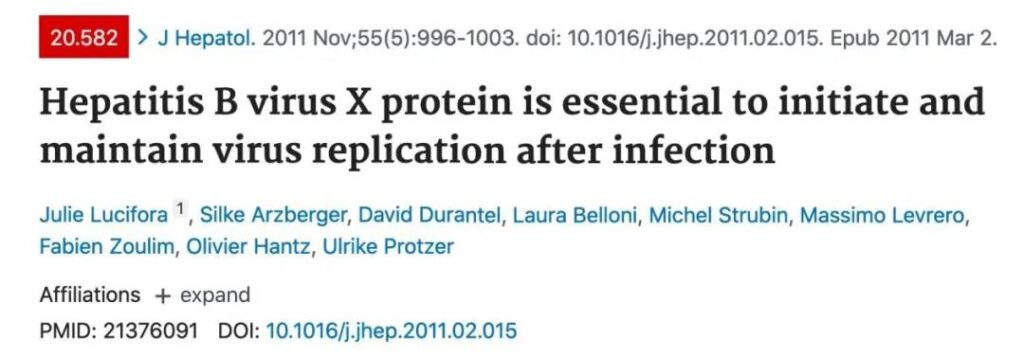
Regarding HBx’s influence on HBV replication, although some research results suggest the pleiotropy of HBx function, none of them has evaluated the role of HBx in a complete infection cycle. Using freshly prepared human primary hepatocytes (PHH) and the HepaRG cell line that supports HBV infection and replication in two in vitro HBV infection models, this article proves that when the HBV wild-type transcription template (ie, cccDNA) has been established, HBx is effective in proliferation Sexual HBV infection is essential.
1. In liver cancer cells that integrate the HBV genome, HBx is not necessary for effective viral particle production
HBV particles are produced by human liver cancer cell lines that stably proliferate HBV: HBV (wt) comes from HepG2.2.15 and HepG2 H1.3 cell lines. HBV(x⁻) comes from the HepG2 H1.3Δx cell line, which replicates HBV through a linearized 1.3-fold ultra-long genome. Analysis of the concentrated supernatant showed that the coated HBV particles were released in HepG2.2.15, HepG2 H1.3 and HepG2 H1.3Δx cell lines.
2. HBx is neither necessary for the virus to enter the host nor for the formation of cccDNA
Infect fresh PHH or HepaRG cells with wild-type or HBx-deficient HBV, and analyze whether there is proliferative HBV infection two weeks later. Similar to expectations, cccDNA was detected early in infection in cells inoculated with HBV (wt) (Figures 1A, B and 2A, B), resulting in HBV RNA transcription (Figures 1C, D and 2C, D), HBeAg and HBsAg secretion ( Figure 1E and 2E). On the contrary, HBV RNA, rcDNA, HBeAg and HBsAg were almost undetectable in the cells inoculated with HBV(x⁻). Although the content of cccDNA in the two groups was basically the same, the group of HBV inoculated with HBV(x⁻) did not secrete HBV.
In summary, HBx neither affects the entry of the virus into host cells nor the establishment of nuclear HBV cccDNA. However, it seems to be crucial to a downstream step, viral RNA transcription.
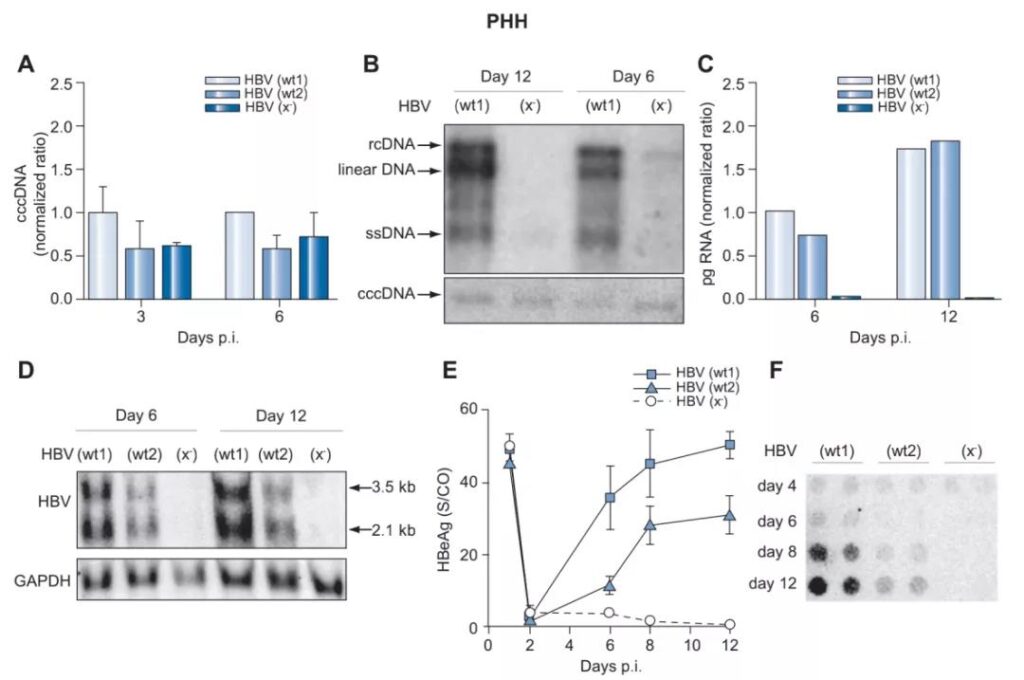
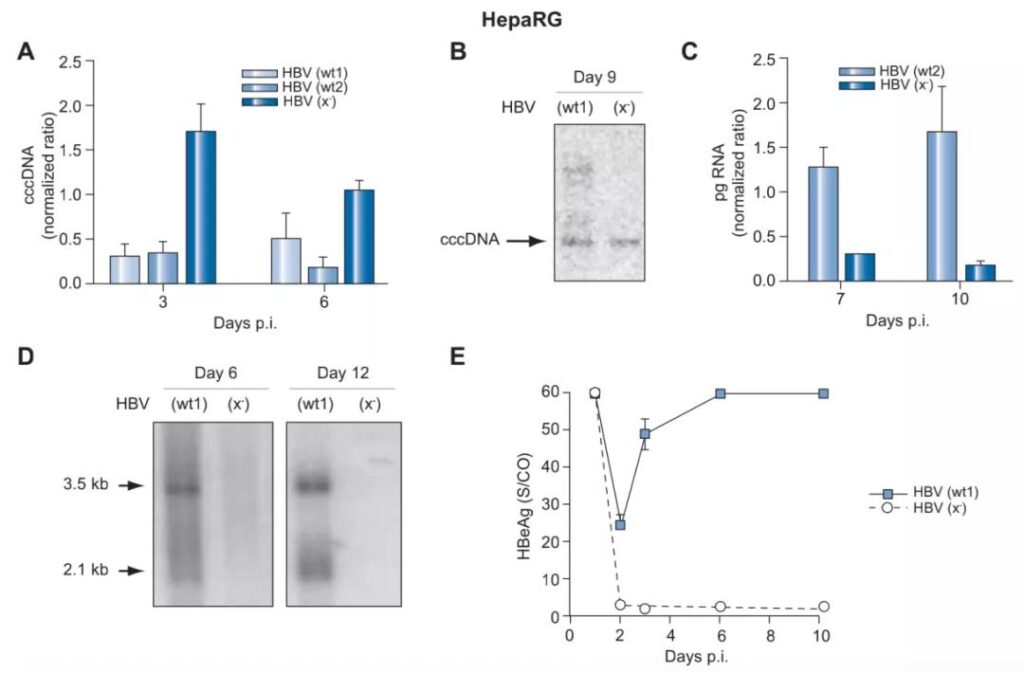
3. HBx is necessary for the initiation and maintenance of transcription using cccDNA as a template
In order to verify that the lack of HBV transcripts is due to the lack of HBx, a new HepaRG-TR-X cell line was constructed in this paper, which can express HBx protein under a certain concentration of tetracycline (Tet) induced. The results showed that using HBV(x⁻) to induce HBx expression at any time point from 1 to 42 days after infection with HepaRG-TR-X can rescue the secretion of HBeAg (Figure 3A). Finally, when the addition of Tet was stopped, the levels of pgRNA, HBV DNA, HBeAg, and HBsAg decreased, but when HBx was induced to express again, viral replication could be restored again (Figure 4), indicating that HBV transcription and replication continue to require HBx.
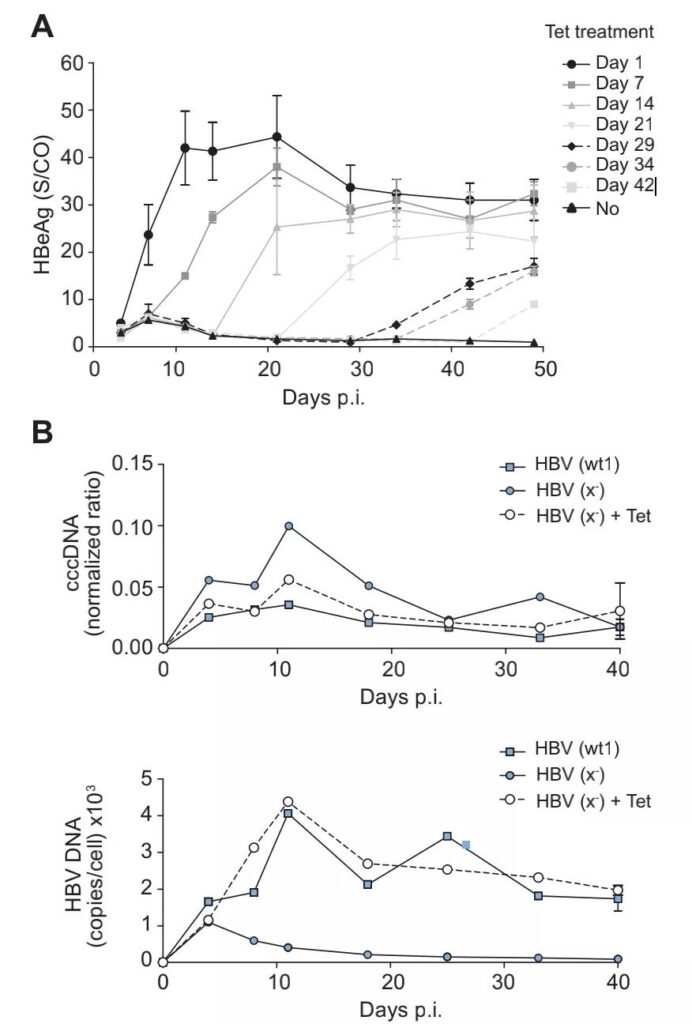
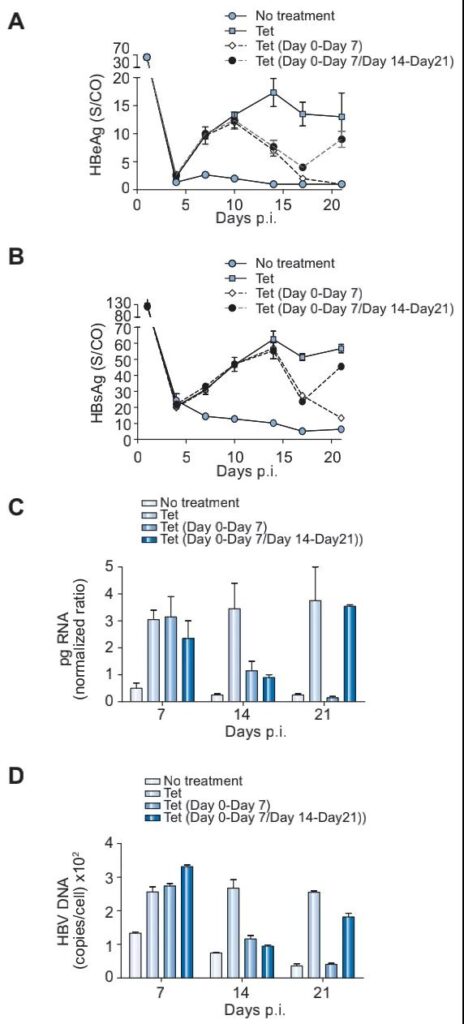
Figure 4. HBx is necessary to maintain HBV replication.
4. The expression of HBx is necessary for the epigenetic modification of cccDNA to initiate the transcription of HBV RNA
There are two possibilities for the origin of HBx: HBx protein may be contained in virus particles and promote transcription after release; or HBx may be re-expressed. In order to verify the former hypothesis, this article modified the HepG2 H1.3Δx cell line through stable transduction of HBx to obtain HBV(x⁻) particles produced in the presence of HBx (Figure 5A), called HBV(x⁻x⁺) ). HBV (x⁻x⁺) and HBV (x⁻) were inoculated into HepaRG-TR-X cells, and the results showed that neither of them could detect HBV gene expression unless induced by Tet (Figure 5B).
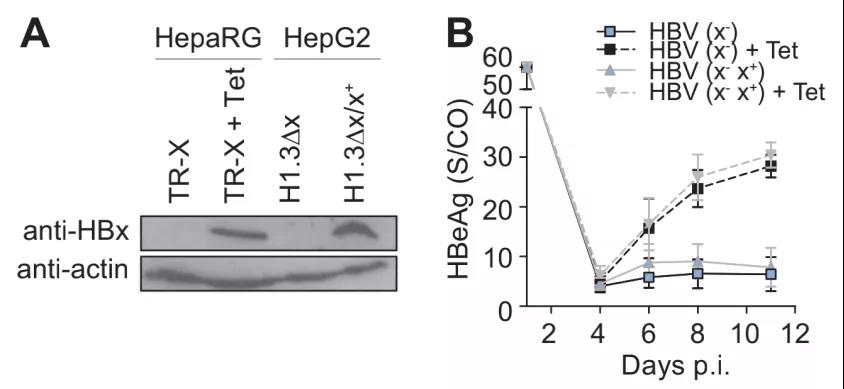
Since the HBx protein in the virus particle is not enough to support HBV transcription, this paper assumes that the continued existence of HBx is necessary to maintain the active transcription conformation of HBV cccDNA. Studies have shown that HBx is conducive to histone acetylation and epigenetically regulates the transcription of plasmid-derived HBV DNA. The author of this article analyzed the acetylation status of cccDNA binding histone H3 by ChIP and found that it was reduced by 93%, which supports the above conclusion. It can be seen that the transcriptional active state of cccDNA continuously requires HBx.
Summary:
This article uses PHH, differentiated HepaRG cells to study the role of HBx in the context of HBV infection. Proliferative infection was easily detected in the cells inoculated with HBV (wt), but no proliferative infection was detected in the cells inoculated with HBV (x⁻). Although the two have established a considerable number of transcription templates, the latter’s transcription and protein expression processes are significantly impaired, which proves the dependence of HBV on HBx. Studies have also shown that HBx does not determine the ability of HBV to enter host cells, but is essential for the natural transcription of HBV cccDNA.
Because HBx is very important in the replication after HBV infection, the author of this article believes that it may be a potential target for the treatment of chronic HBV infection.
(source:internet, reference only)
Disclaimer of medicaltrend.org



